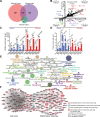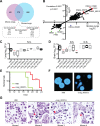Unveil the transcriptional landscape at the Cryptococcus-host axis in mice and nonhuman primates
- PMID: 31329596
- PMCID: PMC6675133
- DOI: 10.1371/journal.pntd.0007566
Unveil the transcriptional landscape at the Cryptococcus-host axis in mice and nonhuman primates
Abstract
Pathogens and hosts require rapid modulation of virulence and defense mechanisms at the infection axis, but monitoring such modulations is challenging. In studying the human fungal pathogen Cryptococcus neoformans, mouse and rabbit infection models are often employed to shed light on the disease mechanisms but that may not be clinically relevant. In this study, we developed an animal infection model using the non-human primate cynomolgus monkey Macaca fascicularis. In addition, we systematically profiled and compared transcriptional responses between the infected mice and the cynomolgus monkey, using simultaneous or dual RNA next-generation sequencing. We demonstrated that there are shared but distinct transcriptional profiles between the two models following C. neoformans infection. Specifically, genes involved in immune and inflammatory responses are all upregulated. Osteoclastogenesis and insulin signaling are also significantly co-regulated in both models and disrupting an osteoclastogenesis-associated gene (OC-STAMP) or the insulin-signaling process significantly altered the host tolerance to C. neoformans. Moreover, C. neoformans was shown to activate metal sequestration, dampen the sugar metabolism, and control cell morphology during infection. Taking together, we described the development of a non-human primate model of cryptococcosis that allowed us to perform an in-depth analysis and comparison of transcriptome profiles during infections of two animal models and conceptually identify host genes important in disease responses. This study provides new insights in understanding fungal pathogenesis mechanisms that potentially facilitate the identification of novel drug targets for the treatment of cryptococcal infection.
Conflict of interest statement
The authors have declared that no competing interests exist.
Figures







Similar articles
-
Cryptococcus neoformans Evades Pulmonary Immunity by Modulating Xylose Precursor Transport.Infect Immun. 2020 Jul 21;88(8):e00288-20. doi: 10.1128/IAI.00288-20. Print 2020 Jul 21. Infect Immun. 2020. PMID: 32423915 Free PMC article.
-
LincR-PPP2R5C deficiency enhancing the fungicidal activity of neutrophils in pulmonary cryptococcosis is linked to the upregulation of IL-4.mBio. 2024 Oct 16;15(10):e0213024. doi: 10.1128/mbio.02130-24. Epub 2024 Sep 17. mBio. 2024. PMID: 39287443 Free PMC article.
-
DAP12 Inhibits Pulmonary Immune Responses to Cryptococcus neoformans.Infect Immun. 2016 May 24;84(6):1879-86. doi: 10.1128/IAI.00222-16. Print 2016 Jun. Infect Immun. 2016. PMID: 27068093 Free PMC article.
-
Role of dendritic cell-pathogen interactions in the immune response to pulmonary cryptococcal infection.Future Microbiol. 2015;10(11):1837-57. doi: 10.2217/fmb.15.92. Future Microbiol. 2015. PMID: 26597428 Free PMC article. Review.
-
Innate host defenses against Cryptococcus neoformans.J Microbiol. 2016 Mar;54(3):202-11. doi: 10.1007/s12275-016-5625-7. Epub 2016 Feb 27. J Microbiol. 2016. PMID: 26920880 Review.
Cited by
-
Integrative Proteome and Acetylome Analyses of Murine Responses to Cryptococcus neoformans Infection.Front Microbiol. 2020 Apr 17;11:575. doi: 10.3389/fmicb.2020.00575. eCollection 2020. Front Microbiol. 2020. PMID: 32362878 Free PMC article.
-
A fungal lytic polysaccharide monooxygenase is required for cell wall integrity, thermotolerance, and virulence of the fungal human pathogen Cryptococcus neoformans.PLoS Pathog. 2023 Apr 26;19(4):e1010946. doi: 10.1371/journal.ppat.1010946. eCollection 2023 Apr. PLoS Pathog. 2023. PMID: 37099613 Free PMC article.
-
Cryptococcal nutrient acquisition and pathogenesis: dining on the host.Microbiol Mol Biol Rev. 2025 Mar 27;89(1):e0001523. doi: 10.1128/mmbr.00015-23. Epub 2025 Feb 10. Microbiol Mol Biol Rev. 2025. PMID: 39927764 Review.
-
Reimagining the future of African brain health: Perspectives for basic research on the pathogenesis of cryptococcal meningitis.Brain Behav Immun Health. 2021 Nov 12;18:100388. doi: 10.1016/j.bbih.2021.100388. eCollection 2021 Dec. Brain Behav Immun Health. 2021. PMID: 34825235 Free PMC article.
-
Developing mRNA lipid nanoparticle vaccine effective for cryptococcosis in a murine model.NPJ Vaccines. 2025 Feb 4;10(1):24. doi: 10.1038/s41541-025-01079-z. NPJ Vaccines. 2025. PMID: 39905025 Free PMC article.
References
Publication types
MeSH terms
Substances
LinkOut - more resources
Full Text Sources
Molecular Biology Databases

